|
BOTTICELLI - BANQUET IN A PINE FOREST
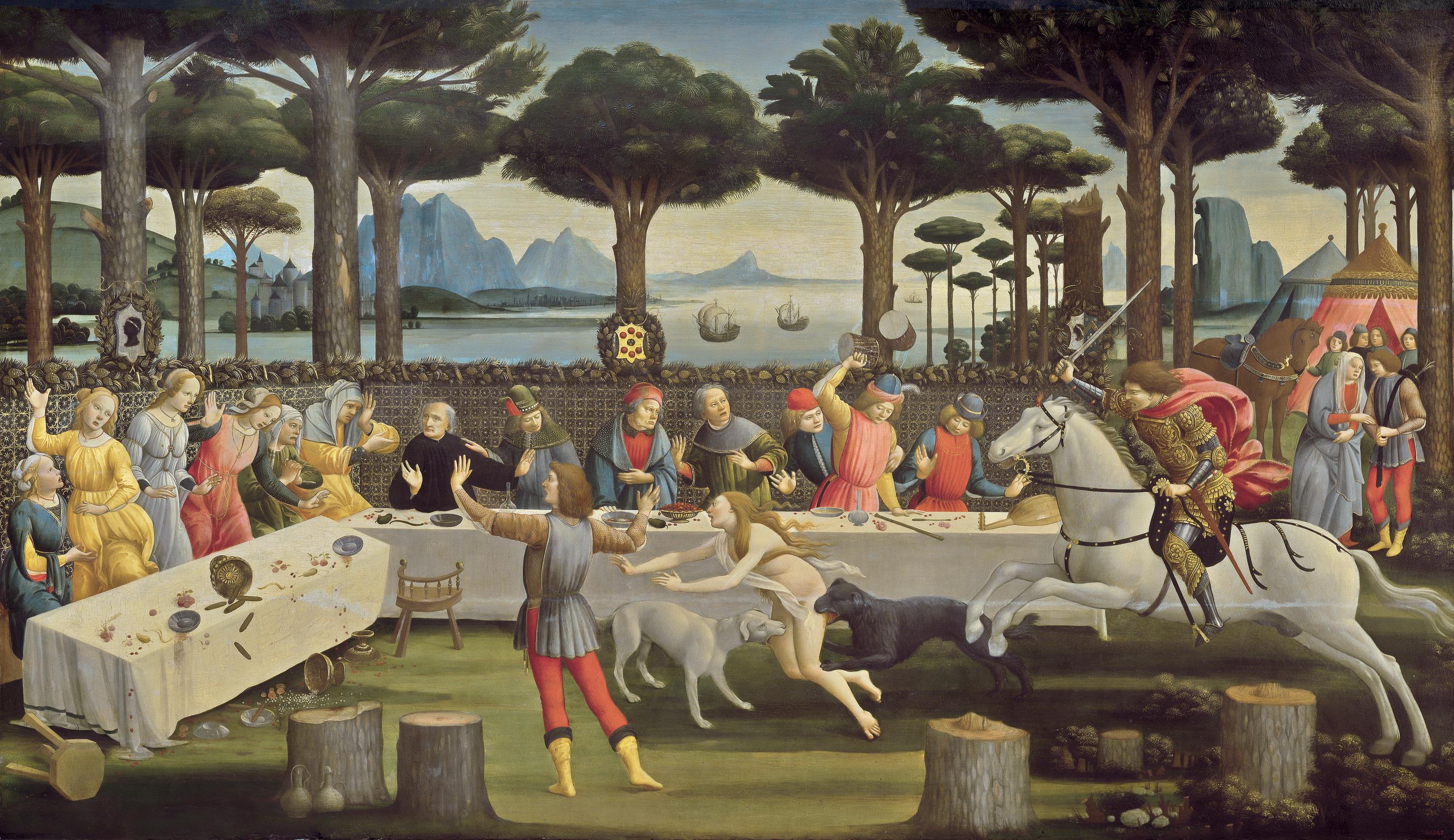
Sandro Botticelli, Public domain, via Wikimedia Commons
1483 |
|
- Also called The story of Nastagio degli Onest
and The Banquet in the Forest.
- Example of Early Renaissance
painted in 1483.
- Currently housed in the Museo del Prado in Madrid, Spain.
- Tempera on wood panel.
- The painting is a part of a series of four panels commissioned by Lorenzo the Magnificent
and is third in the series.
- This is a part of a series illustrating Boccaccio's The Story of Nastagio degli Onesti.
|
The painting's themes of love, despair, and the macabre, along with Botticelli's distinctive style, have made it a subject of scholarly analysis and artistic reproduction.
(Assistant)
|
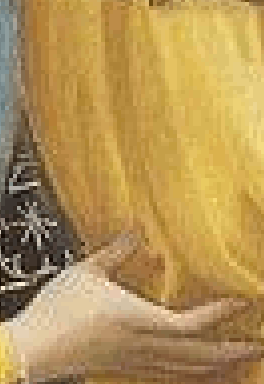
Future bride |
- Thought to have been a gift from Lorenzo the Magnificent in 1483 to Giannozzo Pucci at his marriage to Lucrezia Bini.
- Some say it was commissioned by Antonio Pucci, on the
marriage of his son.
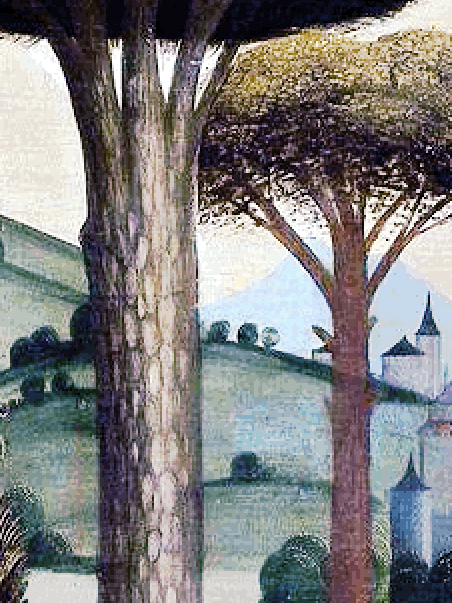
Story line
Four painted panels |
- Alongside this panel,
the remaining three panels were called Nastagio Meets the Woman and the Knight in the Pine Forest of Ravenna, the brutal
Killing the Woman and the last panel Marriage
of Nastagio degli Onesti.
- The banquet in the pine forest develops in a natural
environment full of trees, which not only frame the scene,
but also evoke a sense of intimacy and isolation.
|
The artist took several related episodes from a collection of short stories to inspire the content for four panel paintings. He was commissioned by Lorenzo the Magnificent in 1483 for this project and we can tackle the different artworks one by one.
(thehistoryofart.org)
|
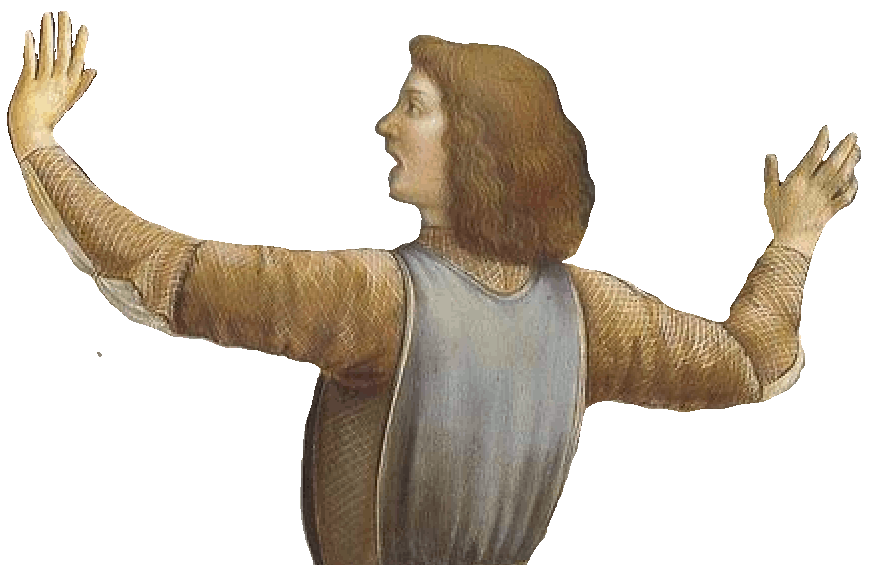
Nastagio degli Onesti |
-
Nastagio degli Onesti is the protagonist in one of the 100 short stories contained in
The Decameron by Giovanni Boccaccio, La historia de Nastagio degli Onesti.
|
Boccaccio's Decameron was set in 1348, the text follows ten Florentines who flee to the countryside to escape the Black Death. There, they entertain themselves by telling stories, sharing a total of 100 anecdotes over two weeks.
(Assistant)
|
|
First Panel |
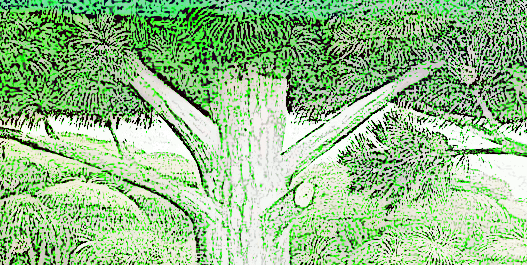
Nastagio meets the woman and the
knight in the pine forest |
- Nastagio degli Onesti, a young nobleman from Ravenna, is in despair because his love for a woman of higher status is unrequited.
- To escape his sorrow, he retreats to the countryside and while wandering, he witnesses a horrifying scene: a knight named Guido degli Anastagi is chasing a naked woman through the woods, accompanied by hounds.
-
Having no sword or other weapon in hand, Nastagio picked up a branch, trying to defend the lady.
- The knight eventually catches the woman, kills her,
and then she is miraculously revived in ghostly form to endure the same torment repeatedly.
|
Tormented by unrequited love, a young nobleman by the name of Nastagio Degli Onesti flees his hometown of Ravenna searching for some faraway place where he wouldn’t be thinking and dreaming of her – the beautiful haughty damsel who rejects him so cruelly over and over again.
(byronsmuse.wordpress.com)
|
|
Second Panel |
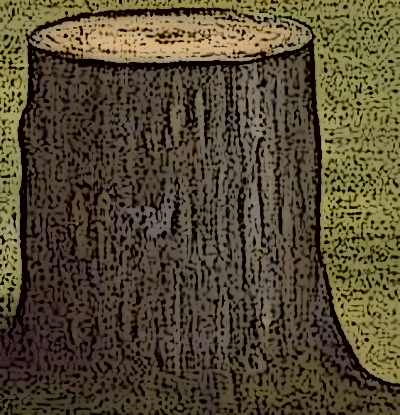
Killing the woman |
- Nastagio learns from the knight's ghost that the woman was once his beloved, who cruelly rejected him, leading him to take his own life.
- As punishment, both are condemned to reenact this gruesome scene every Friday for eternity.
-
This repetitive punishment occurs every Friday and will repeat every Friday for as many years as there were months that the lady rejected Guido.
- A type of death and resurrection.
|
The damsel was pleased that such was the power of her beauty and charm, and she shed not a tear, but very soon she fell ill and died. Having no remorse before her death for her cruel behavior towards Guido, she was condemned to eternity in hell.
(byronsmuse.wordpress.com)
|
|
Third Panel |
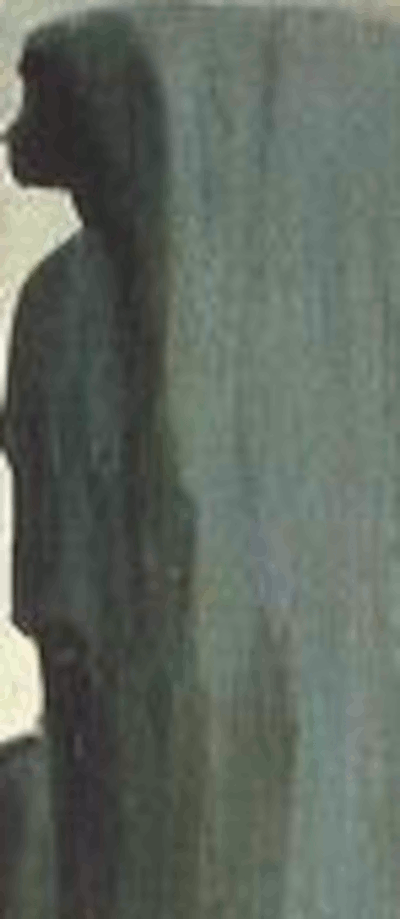
Banquet in a Pine Forest |
- This is the 8th story of the 5th day, it tells of the unrequited love of the nobleman Nastagio for a girl who will eventually be induced to accept Nastagio's affection by the
ghostly recurring appearance of a rejected lover and his beloved.
- The painting depicts a scene from Boccaccio's Decameron, where Nastagio witnesses a gruesome scene of a woman being chased and devoured by hounds.
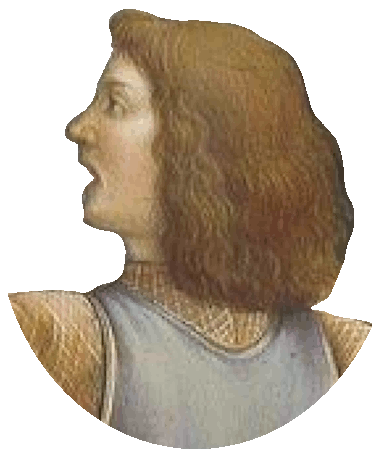
Unrequited lover |
- Nastagio degli Onesti was a noble from Ravenna, made rich after the death of his father and uncle.
- He falls in love with a girl of a noble family, the daughter of Paul Traversari.
- To get her attention, Nastagio begins to squander his money on banquets and parties organized only for her.
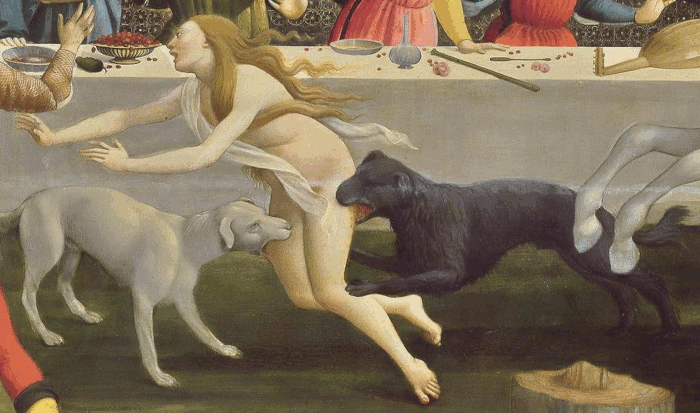
Sacrifice |
- One Friday in early May, Nastagio walked through a pine forest at dusk, where he saw a
ghostly girl running naked in tears.
- She was being chased by two dogs and a
knight with a black sword intending to kill her.
- A dramatic chase unfolds; a
knight astride a white horse, brandishing his weapon, pursues
the
distressed, unclothed woman accompanied by hounds.
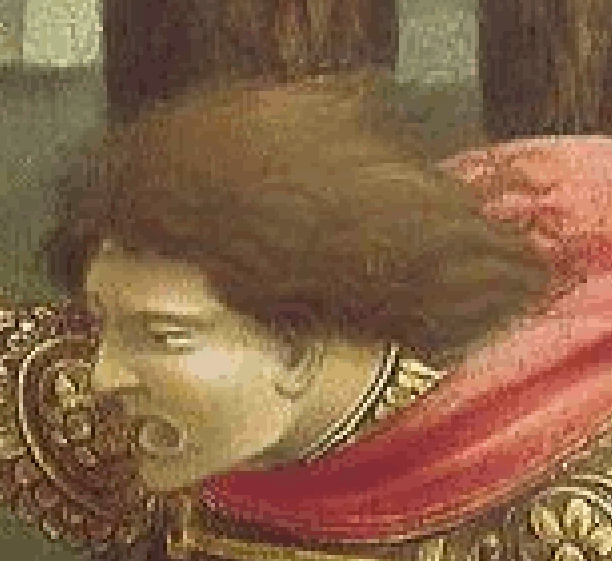
Knight Guido of Anastagi |
-
Nastagio tries to defend her, but the knight presents himself as Guido of Anastagi and tells of how he had once loved this woman, but because she did not love him, he had himself committed suicide.
- When the girl died without any regrets for the misery she had inflicted on her admirer, she was sentenced to the cruel punishment of being hunted.
|
Two characters of the novel, the black knight and the woman on the run, are damned in hell. There has been no sign of repentance for their sins, and that is suicide for him and the refusal of love for her. By Boccaccio, then, love, even in its component hedonistic, receives a positive evaluation: everyone has the right to love and be loved in return, so the woman was guilty for not having loved.
(Wikipedia)
|
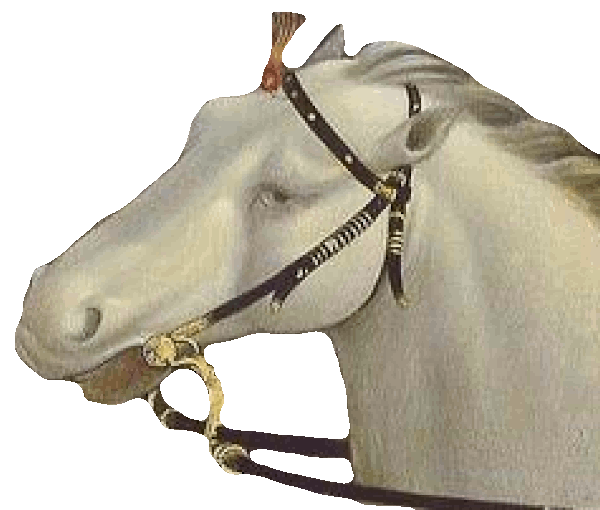
Chase |
-
Nastagio understood the events to be of divine will and resigned himself to being an onlooker.
- He witnessed the agony inflicted on the young girl by the rider, after which the two are forced to start the
ghostly chase again and disappear from Nastagio's sight.
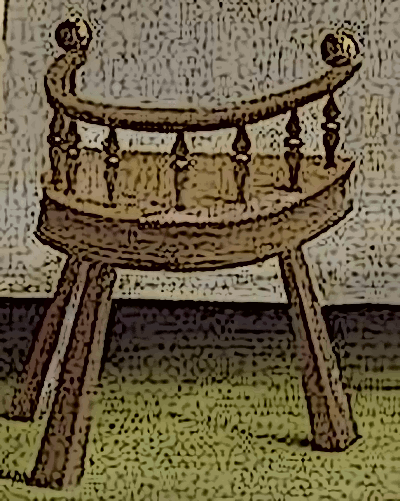
Banquet time |
- Inspired by the supernatural ghostly events, Nastagio devises a plan.
- He invited the woman he loved, along with her family and friends, to a banquet in the woods where the ghostly scene
was about to unfold.
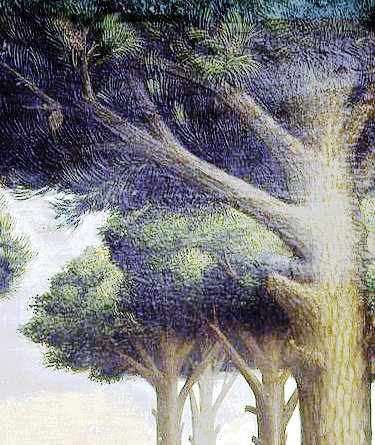
Serene pine forest |
- The trees have narrow trucks with widening at their tips, which allows the artist to use them as decorative features but without covering any of the main detail.
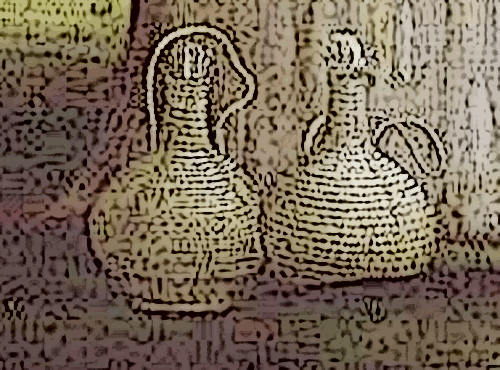
Lavish banquet |
- The young man decided to take advantage of the situation and prepared a lavish banquet in the same place of the forest on the following Friday.
- He invited the relatives of his beloved together with his parents
as well.
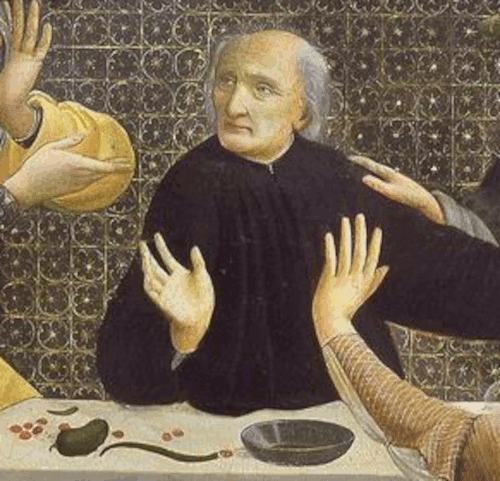
All hands in |
- The scene shows Nastagio, heartbroken in love, hosting a banquet in a pine forest to
make a point about a gruesome ghostly tale of a woman being eternally pursued.
- This scene is meant to be a cautionary tale for Nastagio's unrequited love and her family who are also present.
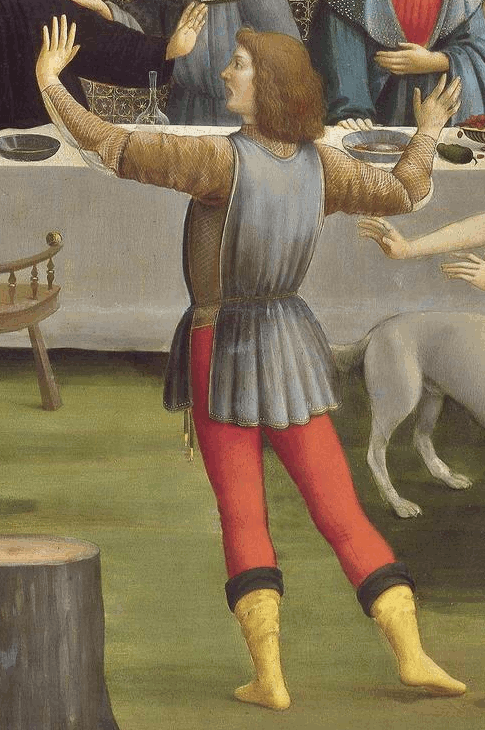
Nastagio the jilted lover |
-
The characters are in a series of dynamic positions, creating a movement effect that flows through painting.
-
The painting depicts an elaborate banquet set in a serene
pine forest.

Group of gentlemen |
- In the center, Nastagio is distinguished, and seems to be arguing with a group of gentlemen
seated at the table.
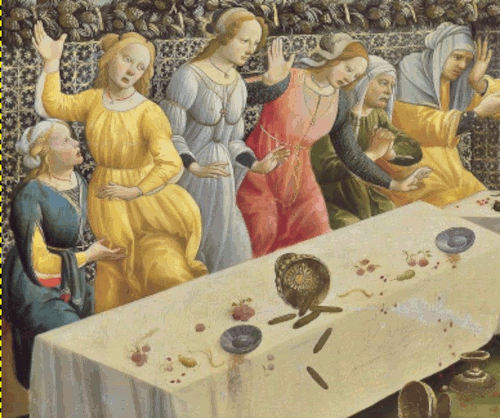
Elaborate banquet |
- It's a scene that can be interpreted as his attempt to win
the attention of the beloved woman, who is apparently part of
the ladies seated to the left at the table.
- Dominating the
painting are large trees that
extend vertically, framing a scene filled with numerous
figures engaged in a variety of activities.
|
In this particular work, Botticelli achieves a composition in which the characteristic elements of their style are appreciated: a careful disposition of the characters, a remarkable visual rhythm and a distinctive use of color.
(kuadros.com)
|
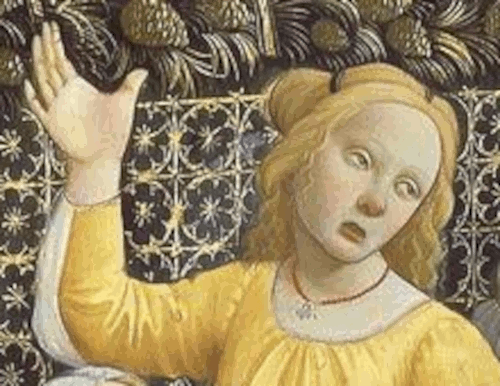
Elegant lady |
- Among them, female figures appear elegantly dressed, their garb and postures add an emotional load to the scene.
- These details underline the idealized aesthetics to which Botticelli is so partial, while the influence of classical culture is evident in the elegance of clothing and in the nature of the banquet.
|
She was exceeding beautiful.
the wild flowers blooming on the hill,
the lily flower, the rose of May —
she was more beautiful than they.
|
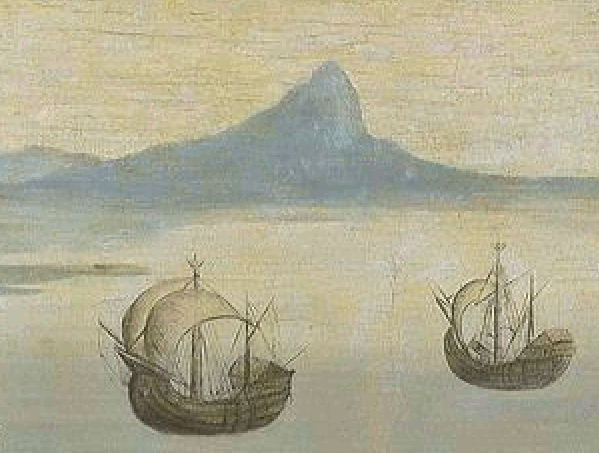
Mountains in the distance |
- In the background there are similar features to those used in the other panels, with
ancient mountains jutting up in the far distance.
- There are some charming ships making their way across
a tranquil sea.
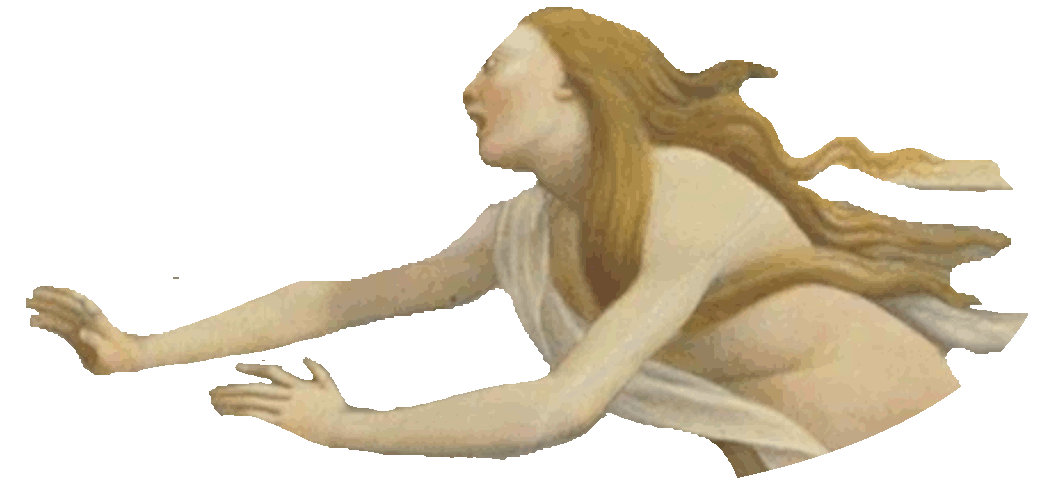
Hate begins |
-
The girl, however, does not return the love of Nastagio; indeed she takes pleasure in refusing it.
- Nastagio tries to forget the noble girl but failing at this he starts to hate her.
- This drives him to attempt suicide several times with no success.
|
Seeing Nastagio's despair, his friends and relatives advise him to go to Ravenna, in order to forget his unfulfilled love. The young man, unable to continue ignoring this advice, moves to Classe, not far from his hometown.
(Wikipedia)
|
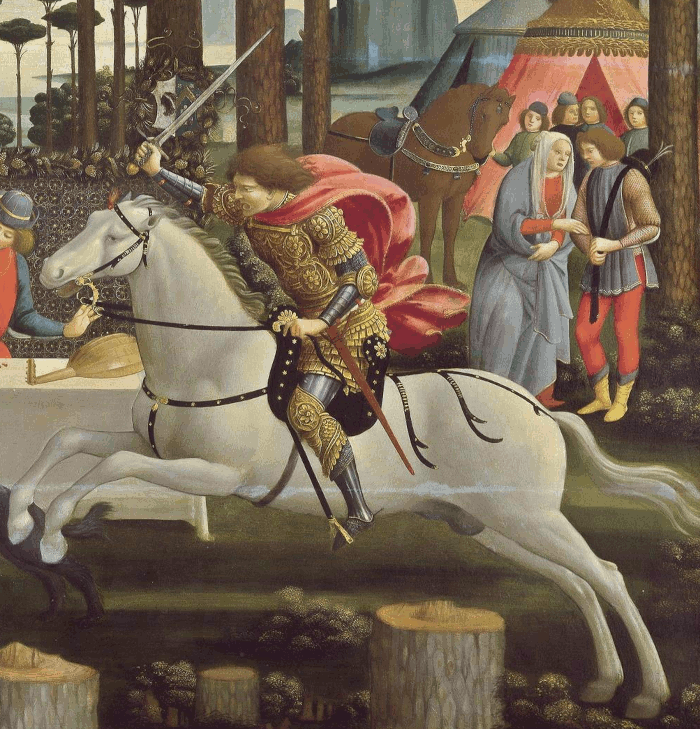
Knight |
- This scene, with the woman being devoured by the hounds, is a visual representation of the consequences of cruelty and rejection in love.
- Nastagio later uses this horror to convince his beloved to accept his
offer.
- The scene, in a way, represents the 'infernal hunt,' present in
Dante's Divine Comedy.
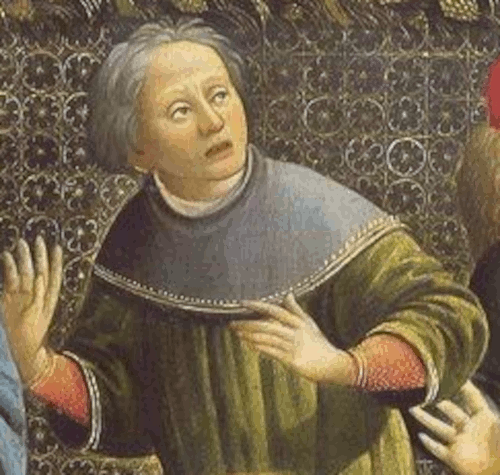
Shock and horror |
-
On the left and center, guests at the banquet table exhibit
mixed reactions ranging from shock to horror as they witness
the turmoil.
- The main characters are arranged on an arboreal background that gives them an almost sacred character, highlighting the importance of the action that arises before our eyes.
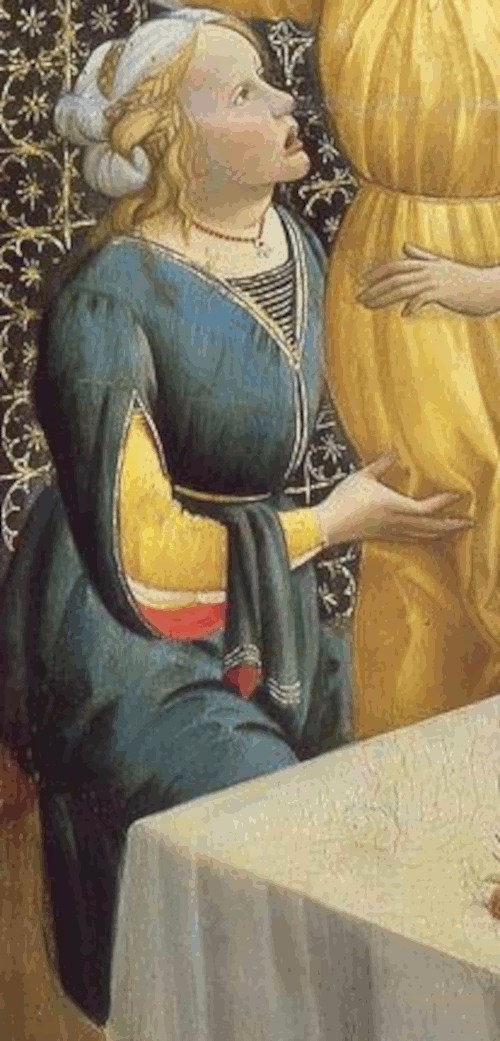
Banquet guest |
- As Nastagio predicted, at the end of the dinner the horrifying scene is repeated with the same harrowing and pitiful consequences.
- This gives him the desired effect because after the hunter once again explains the reasons for the girl's fate to all of those present at the dinner, the girl loved by Nastagio realizes she had stepped on the love felt by Nastagio.
- When his beloved witnesses the violent spectacle, she is horrified and realizes the consequences of cruelty.
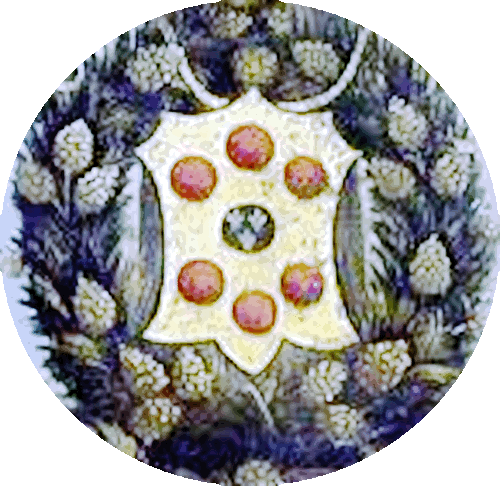
Medici oranges |
- Instantly in fear of suffering the same fate of the victim before her, she changes her mind and immediately agrees to the marriage, transforming his hate into love.
- So the Sunday after they marry, and all the women of
Ravenna learn to be more kind to their love.
|
The symbolic references to Lorenzo de’ Medici within the painting: the Medici coat of arms at the top of the central column, for example, with its six red balls that may – or may not – originally have symbolised oranges. Another is the laurel trees that adorn the three pillars in the foreground, the laurel having featured in Lorenzo’s impresa, or personal emblem, perhaps as a play on his first name, which equates to Laurentius in Latin, while the laurel’s Latin name is Laurus.
(jaxroe.blogspot.com)
|
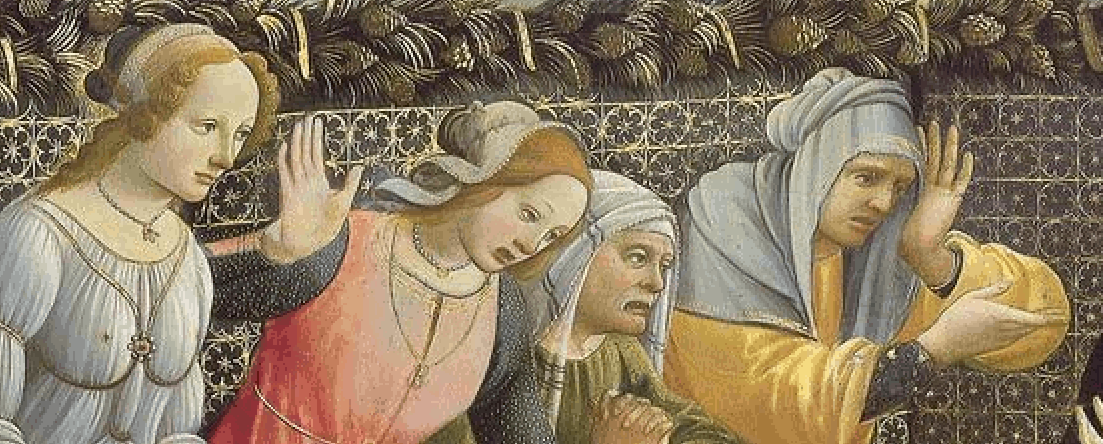
Colorful clothing |
- Botticelli limited the palette for clothing colors, with most figures wearing dresses in yellow, blue and pink.
- The detail across the piece is exquisite, with much to enjoy for those able to see this artwork up close.
- A palette composed of deep green, ochre and
terracotta hues, promotes a warm and cozy atmosphere,
contrasting with the possible implicit tragedy of the
history of Nastagio.
|
This tonal choice not only beautifies the scene, but also reinforces the thematic duality of the work, expressing a sense of celebration that is juxtaposed with the dramatic background of the story that is narrated.
(kuadros.com)
|
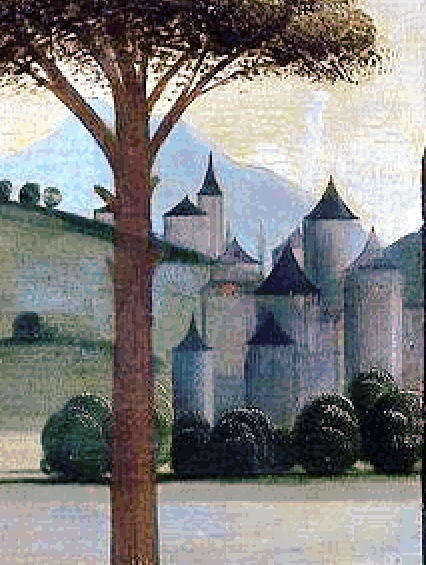
Castle and distant hills |
-
The complex foreground is coupled with a detailed landscape
in the background.
- One which includes a distant view of hills, a
castle, and ships sailing on a tranquil body of water,
all contributing to the dynamic narrative of the artwork.
-
The representation of nature plays an essential role.
- Botticelli is known for his ability to show the beauty of the natural world, a feature that crystallizes in the meticulous treatment of trees and vegetation that
encircles the scene.
|
All manner of animals and touches of nature are included here that you might not notice until your third or fourth time looking at the painting. Botticelli chooses here to separate the foreground and background in a fairly clear fashion that might remind some of the art of the Middle Ages, even though Botticelli himself was generally a fairly innovative artist.
(thehistoryofart.org)
|
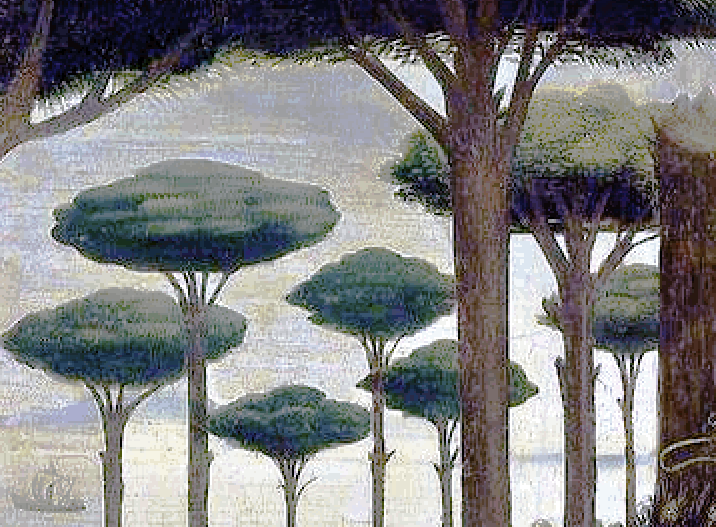
Tragic narrative |
- This painting belongs to a series that are used to illustrate the history of Nastagio
who was a young nobleman from Ravenna.
- In his search for love,
gets caught in a tragic narrative of death and redemption.
|
This work, like the others in the cycle, is impregnated with a deep symbolic burden that reflects human psychology and duality between love and violence.
(kuadros.com)
|
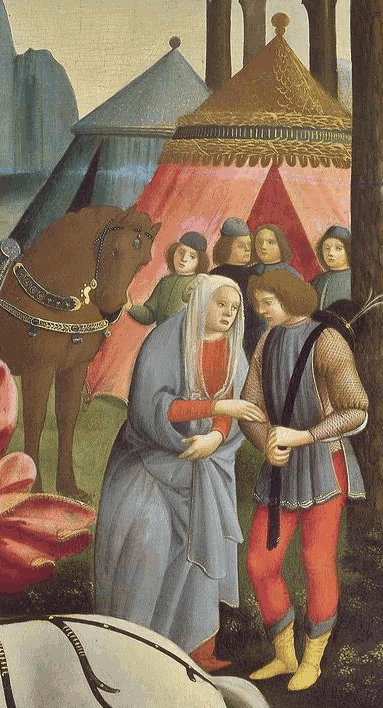
Nastagio and his servants |
-
Here we see Nastagio on his walk in the woods with his
servants.
- This attention to detail reflects
not only the painter's technical mastery, but also its
inclination to create a visual dialogue between the human
being and the environment, an issue that resonates in many of
Botticelli's works.
- The work belongs to the period of Lorenzo de 'Medici and is a reflection of his interest in literary culture and mythological stories.
|
The work is not only a testimony of its technical mastery, but also a reflection on the human condition, a transcendental theme that continues to resonate in contemporary art.
(kuadros.com)
|
|
Fourth Panel |
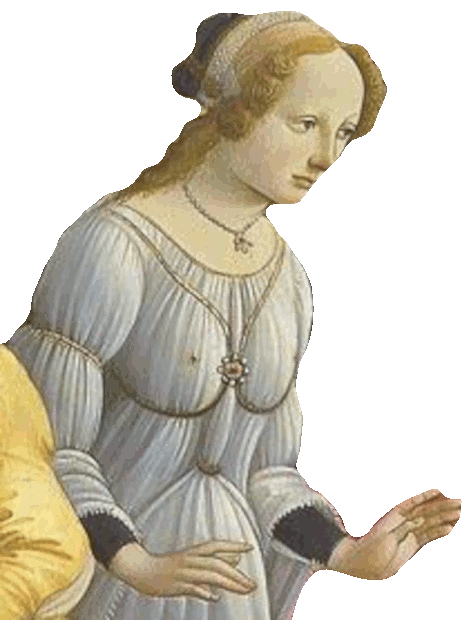
Marriage of Nastagio degli Onesti |
- Moved by fear, Nastagio’s beloved agrees to marry him, and the final scene depicts their wedding feast.
- Future bride is a Venus type.
- The once heartless woman now submits to marriage, fearing the same fate as the woman in the ghostly tale.
|
The theme was chosen for its happy ending, I mean,
they do get married in the end, but still. Now the
paintings are, luckily, not gracing the walls of any
poor couple’s bedroom, they are in Museo del Prado.
(byronsmuse.wordpress.com)
|
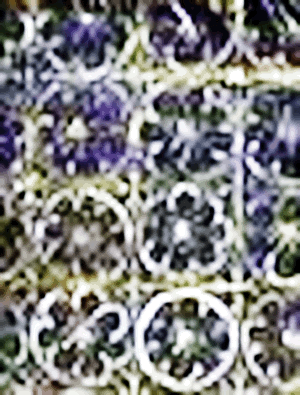
Flower of Life |
Moral of the myth!
- If someone spurns yous love and is very cruel
and is an arrogant haughty narcissist and they take
joy rubbing it in your face, that is one thing, and
they will face karma for it.
- The demons in the Bible are the narcissists.
- On the other hand, if this woman simply had no
interest in him, then his reaction is not even moral,
forcing her to be with him goes against her free will
and this will be a reluctant love.
- The entire scene comes straight out of the Old
Testament and the maltreatment of the female and
the crimes men performed against her and their
oftentimes false fire and brimstone.
|
|

